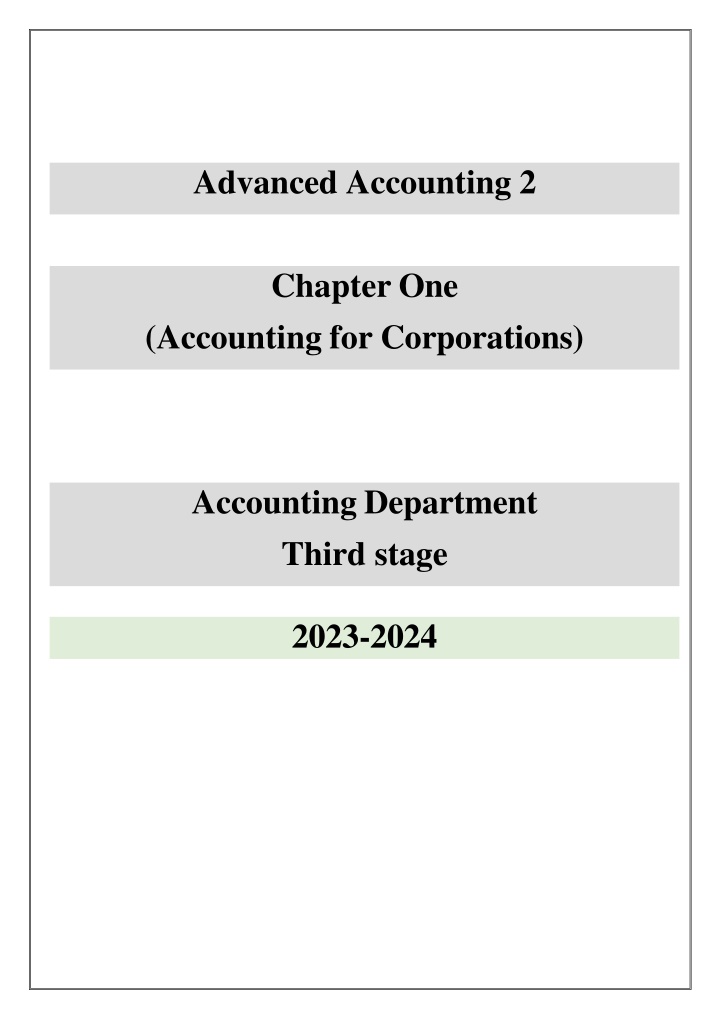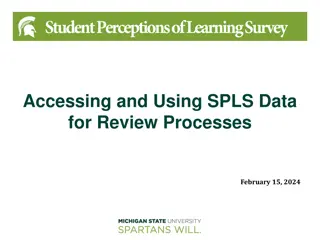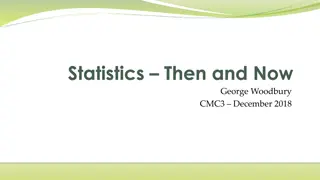
Corporation Characteristics and Stockholders' Rights
Learn about the characteristics that distinguish corporations from proprietorships and partnerships, such as separate legal existence and limited liability. Explore stockholders' rights including voting, dividends, and preemptive rights. Understand stock issue considerations like authorized stock, issuance of stock, market value, and par value stocks. Discover the components of corporate capital including paid-in capital and retained earnings.
Download Presentation

Please find below an Image/Link to download the presentation.
The content on the website is provided AS IS for your information and personal use only. It may not be sold, licensed, or shared on other websites without obtaining consent from the author. If you encounter any issues during the download, it is possible that the publisher has removed the file from their server.
You are allowed to download the files provided on this website for personal or commercial use, subject to the condition that they are used lawfully. All files are the property of their respective owners.
The content on the website is provided AS IS for your information and personal use only. It may not be sold, licensed, or shared on other websites without obtaining consent from the author.
E N D
Presentation Transcript
Advanced Accounting 2 Chapter One (Accounting for Corporations) Accounting Department Third stage 2023-2024
Chapter one Accounting for Corporations Corporation A corporation is a business organization that has a separate legal personality from its owners. Ownership in a stock corporation is represented by shares of stock. The owners (stockholders) enjoy limited liability but have limited involvement in the company's operations. The board of directors, an elected group from the stockholders, controls the activities of the corporation. Characteristics of a Corporation A number of characteristics distinguish corporations from proprietorships and partnerships. We explain the most important of these characteristics below. 1. Separate legal existence 2. Limited liability of stockholders 3. Transferable ownership rights 4. Ability to acquire capital 5. Continuous life CORPORATION MANAGEMENT
Stockholders Rights 1. Vote. 2. Dividends. 3. Liquidation. 4. Preemption. Stockholders can maintain their proportionate ownership in the corporation. Suppose you own 5% of a corporation s stock. If the corporation issues 100,000 new shares of stock, it must offer you the opportunity to buy 5% (5,000) of the new shares. This right, called the preemptive right, is usually withheld from the stockholders. Stock Issue Considerations 1. Authorized Stock The authorization of capital stock does not result in a formal accounting entry. This event has no immediate effect on either corporate assets or stockholders equity. However, the number of authorized shares is often reported in the stockholders equity section. It is then simple to determine the number of unissued shares that the corporation can issue without amending the charter: subtract the total shares issued from the total authorized. For example, if Advanced Micro was authorized to sell 100,000 shares of common stock and issued 80,000 shares, 20,000 shares would remain unissued. 2. Issuance Of Stock A corporation can issue common stock directly to investors. Or it can issue the stock indirectly through an investment banking firm that specializes in bringing securities to market. Direct issue is typical in closely held companies. Indirect issue is customary for a publicly held corporation. 3. Market Value Of Stock The stock of publicly held companies is traded on organized exchanges. The interaction between buyers and sellers determines the prices per share. In general, the prices set by the marketplace tend to follow the trend of a company s earnings and dividends. But, factors beyond a company s control, such as an oil embargo, changes in interest rates, and the outcome of a presidential election, may cause day-to-day fluctuations in market prices. The trading of capital stock on securities exchanges involves the transfer of
already issued shares from an existing stockholder to another investor.These transactions have no impact on a corporation sstockholders equity. 4. Par And No-Par Value Stocks Par value stock is capital stock to which the charter has assigned a value per share. No-par value stock is capital stock to which the charter has not assigned a value. No-par value stock is quite common today. For example, Nike, Procter & Gamble, and North American Van Lines all have no-par stock. In many states the board of directors assigns a stated value to no-par shares. 5. Corporate Capital Owners equity is identified by various names: stockholders equity, shareholders equity, or corporate capital. The stockholders equity section of a corporation s balance sheet consists of two parts: (1) paid-in (contributed) capital and (2) retained earnings (earned capital). 6. Paid-In Capital Paid-in capital is the total amount of cash and other assets paid in to the corporation by stockholders in exchange for capital stock. As noted earlier, when a corporation has only one class of stock, it is common stock. 7. RETAINED EARNINGS Retained earnings is net income that a corporation retains for future use. Net income
Classes of Stock Corporations issue different types of stock. The stock of a corporation may be either common or preferred and either par or no-par. 1. COMMON STOCK Every corporation issues common stock, the basic form of capital stock. The owners of a corporation are the common stockholders. Some companies issue Class A common stock, which carries the right to vote. They may also issue Class B common stock, which may be nonvoting. (Classes of stock may also be designated Series A, Series B, and so on.) There is a separate account for each class of stock. 2. PREFERRED STOCK gives its owners certain advantages over the common stockholders. Preferred stockholders receive dividends before the common stockholders, and they receive assets before the common stockholders if the corporation liquidates. Corporations pay a fixed amount of dividends on preferred stock. Investors usually buy preferred stock to earn those fixed dividends. Owners of preferred stock also have the four basic stockholder rights, unless a right is specifically denied. The right to vote is sometimes withheld from preferred stockholders. Companies may issue different classes of preferred stock (Class Aand Class B, or Series A and Series B, for example). Each class of stock is recorded in a separate account. Preferred stock is rarer than you might think. ACCOUNTING FOR ISSUES OF COMMON STOCK
1. Issuing Par Value Common Stock for Cash assume that Hydro-Slide, Inc. issues 1,000 shares of $1 par value common stock at par for cash. The entry to record this transaction is: Cash 1,000 Common Stock 1,000 (To record issuance of 1,000 shares of $1 par common stock at par) If Hydro-Slide issues an additional 1,000 shares of the $1 par value common stock for cash at $5 per share, the entry is: Cash 5,000 Common Stock Paid-in Capital in Excess of Par Value 1,000 4,000 The total paid-in capital from these two transactions is $6,000, and the legal capital is $2,000. Assuming Hydro-Slide, Inc. has retained earnings of $27,000, the company s stockholders equity section. 2. Issuing No-Par Common Stock for Cash For example, assume that instead of $1 par value stock, Hydro-Slide, Inc. has $5 stated value no-par stock and the company issues 5,000 shares at $8 per share for cash. The entry is: Cash 40,000 Common Stock Paid-in Capital in Excess of Stated Value 15,000 (To record issue of 5,000 shares of $5 stated value noparstock) 25,000
Hydro-Slide, Inc. reports Paid-in Capital in Excess of Stated Value as part of paid in capital in the stockholders equity section. What happens when no-par stock does not have a stated value? In that case, the corporation credits the entire proceeds to Common Stock. Thus, if Hydro-Slide does not assign a stated value to its no-par stock, it would record the issuance of the 5,000 shares at $8 per share for cash as follows. Cash 40,000 Common Stock 40,000 (To record issue of 5,000 shares of no-par stock) 3. Issuing Common Stock for Services or Noncash Assets To illustrate, assume that attorneys have helped Jordan Company incorporate. They have billed the company $5,000 for their services. They agree to accept 4,000 shares of $1 par value common stock in payment of their bill. At the time of the exchange, there is no established market price for the stock. In this case, the market value of the consideration received, $5,000, is more clearly evident. Accordingly, Jordan Company makes the following entry: Organization Expense 5,000 Common Stock Paid-in Capital in Excess of Par Value 1,000 (To record issuance of 4,000 shares of $1 par value stock to attorneys) In contrast, assume that Athletic Research Inc. is an existing publicly held corporation. Its $5 par value stock is actively traded at $8 per share. The company issues 10,000 shares of stock to acquire land recently advertised for sale at $90,000.The most clearly evident value in this noncash transaction is the market price of the consideration given, $80,000.The company records the transaction as follows. Land 80,000 Common Stock Paid-in Capital in Excess of Par Value (To record issuance of 10,000 shares of $5 par value stock for land) 4,000 50,000 30,000 ACCOUNTING FOR PREFERRED STOCK Like common stock, corporations may issue preferred stock for cash or for noncash assets. The entries for these transactions are similar to the entries for common stock. When a corporation has more than one class of stock, each paid-in capital account title should identify the stock to which it relates. A company might have the following accounts: Preferred Stock, Common Stock, Paid-in Capital in Excess of Par Value Preferred Stock, and Paid-in Capital in Excess of Par Value Common Stock. For example, if Stine Corporation issues 10,000 shares of $10 par value preferred stock for $12 cash per share, the entry to record the issuance is: Cash 120,000 Preferred Stock Paid-in Capital in Excess of Par Value Preferred Stock 20,000 100,000
(To record the issuance of 10,000 shares of $10 par value preferred stock) Example:1 During its first year of operations, Harlan Corporation had the following transactions pertaining to its common stock. Jan. 10 Issued 70,000 shares for cash at $5 per share. July 1 Issued 40,000 shares for cash at $7 per share. Instructions (a) Journalize the transactions, assuming that the common stock has a par value of $5 per share. (b) Journalize the transactions, assuming that the common stock is no-par with a stated value $1 per share. Example:2 Grossman Corporation issued 1,000 shares of stock. Instructions Prepare the entry for the issuance under the following assumptions. (a) The stock had a par value of $5 per share and was issued for a total of $52,000. (b) The stock had a stated value of $5 per share and was issued for a total of $52,000. (c) The stock had no par or stated value and was issued for a total of $52,000. (d) The stock had a par value of $5 per share and was issued to attorneys for services during incorporation valued at $52,000. (e) The stock had a par value of $5 per share and was issued for land worth $52,000.
Example:3 Franco Corporation was organized on January 1, 2010. It is authorized to issue 10,000 shares of 8%, $100 par value preferred stock, and 500,000 shares of no-par common stock with a stated value of $2 per share.The following stock transactions were completed during the first year. Jan. 10 Issued 80,000 shares of common stock for cash at $4 per share. Mar. 1 Issued 5,000 shares of preferred stock for cash at $105 per share. Apr. 1 Issued 24,000 shares of common stock for land. The asking price of the land was $90,000.The fair market value of the land was $85,000. May 1 Issued 80,000 shares of common stock for cash at $4.50 per share. Aug. 1 Issued 10,000 shares of common stock to attorneys in payment of their bill of $30,000 for services provided in helping the company organize. Sept. 1 Issued 10,000 shares of common stock for cash at $5 per share. Nov. 1 Issued 1,000 shares of preferred stock for cash at $109 per share. Instructions (a) Journalize the transactions. (b) Post to the stockholders equity accounts. (Use J5 as the posting reference.) (c) Prepare the paid-in capital section of stockholders equity at December 31, 2010.
Accounting For Treasury Stock Treasury stock is a corporation s own stock that it has issued and subsequently reacquired from shareholders, but not retired. A corporation may acquire treasury stock for various reasons: 1. To reissue the shares to officers and employees under bonus and stock compensation plans. 2. To signal to the stock market that management believes the stock is underpriced, in the hope of enhancing its market value. 3. To have additional shares available for use in the acquisition of other companies. 4. To reduce the number of shares outstanding and thereby increase earnings per share. 5. To rid the company of disgruntled investors, perhaps to avoid a takeover Purchase of Treasury Stock Companies generally account for treasury stock by the cost method. This method uses the cost of the shares purchased to value the treasury stock. Under the cost method, the company debits Treasury Stock for the price paid to reacquire the shares. When the company disposes of the shares, it credits to Treasury Stock the same amount it paid to reacquire the shares.To illustrate, assume that on January 1, 2010, the stockholders equity section of Mead, Inc. has 100,000 shares of $5 par value common stock outstanding (all issued at par value) and Retained Earnings of $200,000. The equity section before purchase of treasury stock is as follows. On February 1, 2010, Mead acquires 4,000 shares of its stock at $8 per share. The entry is: Feb. 1 Treasury Stock 32,000 Cash 32,000 (To record purchase of 4,000 shares of treasury stock at $8 per share)
Disposal of Treasury Stock Treasury stock is usually sold or retired. The accounting for its sale differs when treasury stock is sold above cost than when it is sold below cost. 1.Sale Of Treasury Stock Above Cost If the selling price of the treasury shares is equal to their cost, the company records the sale of the shares by a debit to Cash and a credit to Treasury Stock.When the selling price of the shares is greater than their cost, the company credits the difference to Paid-in Capital from Treasury Stock. To illustrate, assume that on July 1, Mead sells for $10 per share the 1,000 shares of its treasury stock, previously acquired at $8 per share. The entry is as follows. July 1 Cash 10,000 Treasury Stock Paid-in Capital from Treasury Stock (To record sale of 1,000 shares of treasury stock above cost) Mead does not record a $2,000 gain on sale of treasury stock for two reasons: (1) Gains on sales occur when assets are sold, and treasury stock is not an asset. (2) A corporation does not realize a gain or suffer a loss from stock transactions with its own stockholders. Thus, companies should not include in net income any paid-in capital arising from the sale of treasury stock. Instead, they report Paidin Capital from Treasury Stock separately on the balance sheet, as a part of paidin capital. 8,000 2,000 2.Sale Of Treasury Stock Below Cost When a company sells treasury stock below its cost, it usually debits to Paid-in Capital from Treasury Stock the excess of cost over selling price.Thus, if Mead, Inc. sells an additional 800 shares of treasury stock on October 1 at $7 per share, it makes the following entry. Oct. 1 Cash Paid-in Capital from Treasury Stock Treasury Stock 5,600 800 6,400
(To record sale of 800 shares of treasury stock below cost) When a company fully depletes the credit balance in Paid-in Capital from Treasury Stock, it debits to Retained Earnings any additional excess of cost over selling price.To illustrate, assume that Mead, Inc. sells its remaining 2,200 shares $7 per share on December 1. The excess of cost over selling price is $2,200 [2,200 _ ($8 _ $7)]. In this case, Mead debits $1,200 of the excess to Paid-in Capital from Treasury Stock. It debits the remainder to Retained Earnings. The entry is: Dec. 1 Cash Paid-in Capital from Treasury Stock 1,200 Retained Earnings Treasury Stock (To record sale of 2,200 shares of treasury stock at $7 per share) 15,400 1,000 17,600 Example:4 Leone Co. had the following transactions during the current period. Mar. 2 Issued 5,000 shares of $5 par value common stock to attorneys in payment of a bill for $30,000 for services provided in helping the company to incorporate. June 12 Issued 60,000 shares of $5 par value common stock for cash of $375,000. July 11 Issued 1,000 shares of $100 par value preferred stock for cash at $110 per share. Nov. 28 Purchased 2,000 shares of treasury stock for $80,000. Instructions Journalize the transactions. Example:5 As an auditor for the CPA firm of Bunge and Dodd, you encounter the following situations in auditing different clients. 1. Desi Corporation is a closely held corporation whose stock is not publicly traded. On December 5, the corporation acquired land by issuing 5,000 shares of its $20 par value common stock.The owners asking price for the land was $120,000, and the fair market value of the land was $115,000. 2. Lucille Corporation is a publicly held corporation whose common stock is traded on the securities markets. On June 1, it acquired land by issuing 20,000 shares of its $10 par value stock. At the time of the exchange, the land was advertised for sale at $250,000.The stock was selling at $12 per share. Instructions Prepare the journal entries for each of the situations above Example:6 On January 1, 2010, the stockholders equity section of Nunez Corporation shows: Common stock ($5 par value) $1,500,000; paid-in capital in excess of par value $1,000,000; and retained earnings $1,200,000. During the year, the following treasury stock transactions occurred.
Mar. 1 July 1 Sept. 1 Instructions (a) Journalize the treasury stock transactions. (b) Restate the entry for September 1, assuming the treasury shares were sold at $12 per share. Purchased 50,000 shares for cash at $15 per share. Sold 10,000 treasury shares for cash at $17 per share. Sold 8,000 treasury shares for cash at $14 per share. Example:7 Mad City Corporation purchased from its stockholders 5,000 shares of its own previously issued stock for $250,000. It later resold 2,000 shares for $54 per share, then 2,000 more shares for $49 per share, and finally 1,000 shares for $40 per share. Instructions Prepare journal entries for the purchase of the treasury stock and the three sales of treasury stock. Example:8 Polzin Corporation is authorized to issue both preferred and common stock. The par value of the preferred is $50. During the first year of operations, the company had the following events and transactions pertaining to its preferred stock. Feb. 1 Issued 20,000 shares for cash at $53 per share. July 1 Issued 12,000 shares for cash at $57 per share. Instructions (a) Journalize the transactions. (b) Post to the stockholders equity accounts. (c) Indicate the financial statement presentation of the related accounts. Example:9 AI Corporation issued 100,000 shares of $20 par value, cumulative, 8% preferred stock on January 1, 2009, for $2,100,000. In December 2011, AI declared its first dividend of $500,000. Instructions (a) Prepare AI s journal entry to record the issuance of the preferred stock. (b) If the preferred stock is not cumulative, how much of the $500,000 would be paid to common stockholders? (c) If the preferred stock is cumulative, how much of the $500,000 would be paid to common stockholders? Example:10 Roemer Corporation recently hired a new accountant with extensive experience in accounting for partnerships. Because of the pressure of the new job, the accountant was unable to review his textbooks on the topic of corporation accounting. During the first month, the accountant made the following entries for the corporation s capital stock.
Cash 130,000 Capital Stock 130,000 May 2 (Issued 10,000 shares of $10 par value common stock at $13 per share) Cash 600,000 Capital Stock 600,000 (Issued 10,000 shares of $50 par value preferred stock at $60 per share) Capital Stock 15,000 Cash 15,000 (Purchased 1,000 shares of common stock for the treasury at $15 per share) 31 Cash 8,000 10 15 Capital Stock Gain on Sale of Stock 5,000 3,000 (Sold 500 shares of treasury stock at $16 per share) Instructions On the basis of the explanation for each entry, prepare the entry that should have been made for the capital stock transactions. Example:11 Jacobsen Corporation had the following stockholders equity accounts on January 1, 2010: Common Stock ($5 par) $500,000, Paid-in Capital in Excess of Par Value $200,000, and Retained Earnings $100,000. In 2010, the company had the following treasury stock transactions. Mar. 1 Purchased 5,000 shares at $9 per share. June 1 Sold 1,000 shares at $12 per share. Sept. 1 Sold 2,000 shares at $10 per share. Dec. 1 Sold 1,000 shares at $6 per share. Jacobsen Corporation uses the cost method of accounting for treasury stock. In 2010, the company reported net income of $30,000. Instructions Journalize the treasury stock transactions, and prepare the closing entry at December 31, 2010, for net income.



















